Just 100 meters
This week: Just 100 meters; Meanwhile…; Down in the orchard; It worked;

The cold weather last weekend showed up a flaw in my wood stove.
No matter how I tried, I couldn’t get the water temperature above 55ºC. The wood, although completely dry, only burnt sluggishly, even with the chimney fan running almost non stop.
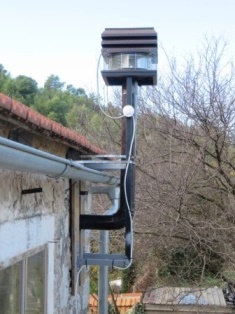
On Monday morning I took the chimney and air radiator apart and cleaned out the inside of the tubes. This hasn’t been done for more than 12 months.
Even after such a long time, there was not a huge amount of carbon or soot on the inside.
I cleaned out about a quarter bucket of shiny carbon residue. There was no evidence of creosote, which is the result of poorly burnt wood.
When I checked, none of the tubes of the air radiator above the stove, had any blockage inside.
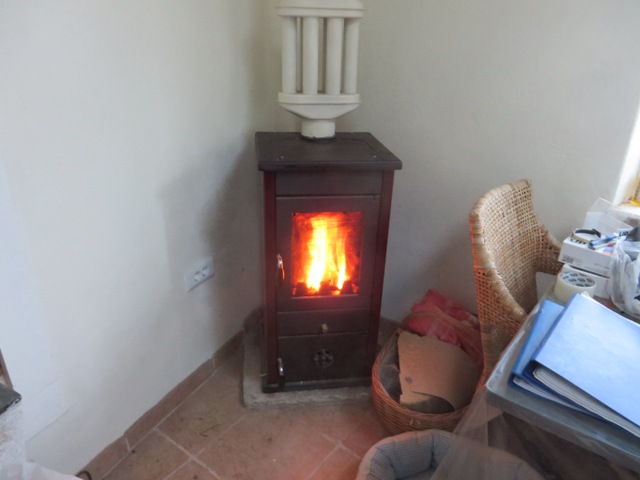
Before the chimney fan was installed I would remove a full bucket of carbon at least twice during the winter burn season.

I lit the fire on Monday afternoon and burnt some pine from my neighbours supply. There was a considerable difference in both the water temperature and heat output.
This winter I have been burning offcuts, pieces of scrap wood from the building work, old beams and pine logs.
I suspect a minor part of the problem may have been the carbon deposits inside the flue. However a greater part of the problem has been the kind of wood I have been burning.
I’ve been offered a couple of pine trees in the forest behind my home. I just need to cut them down!
They are dry and dead but still standing, so I think I will empty the woodshed of the timber I have and then start again with better wood.
I didn’t know there was a “wrong kind” of firewood!
oOo
The photo that I took of the rainbow over Dol a couple of weeks ago has been picked up by the village magazine. It was used as one of their cover photos this week.

But you saw it here on the blog first!
Just 100 meters makes all the difference
We have had some cold nights this week. The temperature has briefly dropped below zero ºC a couple of times.
This has affected my tender Canna Lilies, but they will grow again from the underground corms in the spring.
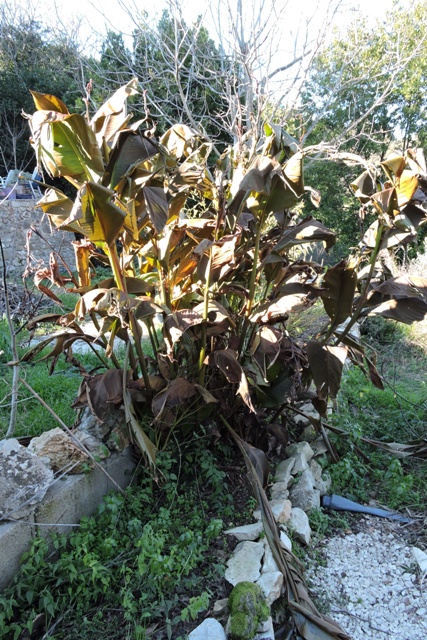
My weather station records data every five minutes, of every hour, of every day and then produces graphs and charts in spreadsheets and on line.
When I looked on Tuesday morning, in the chart there is a period of an hour and a half from 06:00 when the temperature was exactly 0ºC.
This was the morning when we actually had the first frost of this winter.
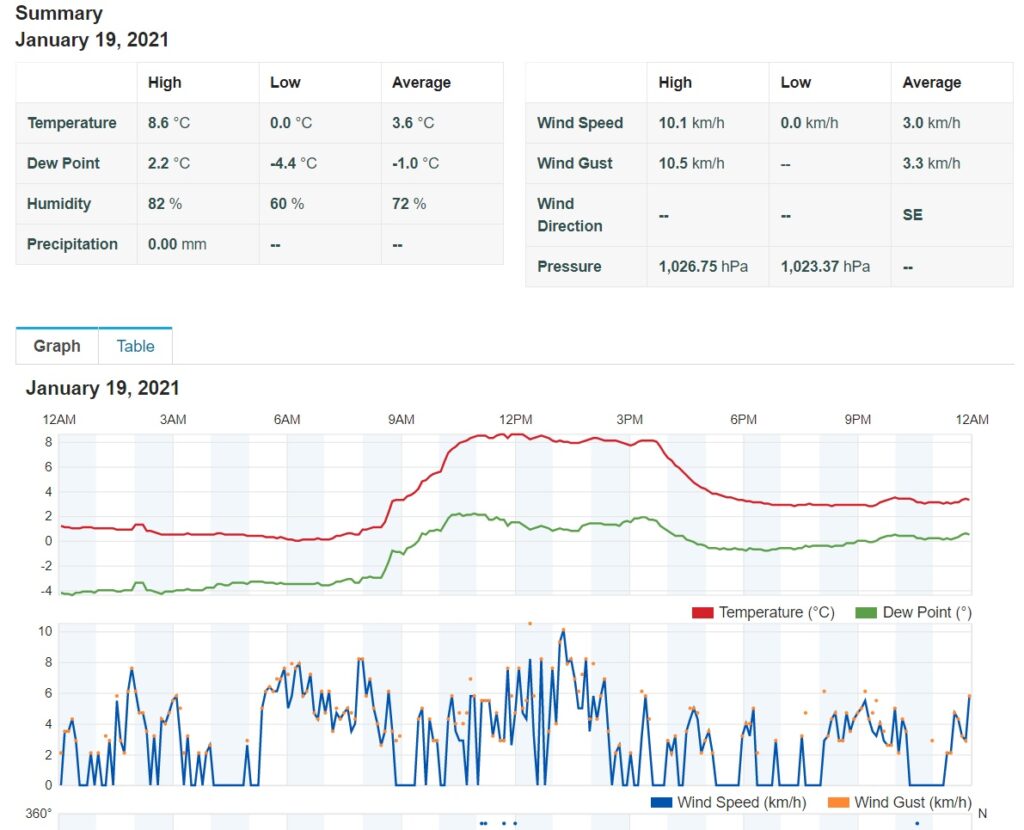
There is a very old weather saying that the coldest hour is just before the dawn. Meteorological observations actually show that it is usually just after dawn.
Thinking about observations on a night with a clear sky and nearly zero wind at the surface, this is what it would look like.
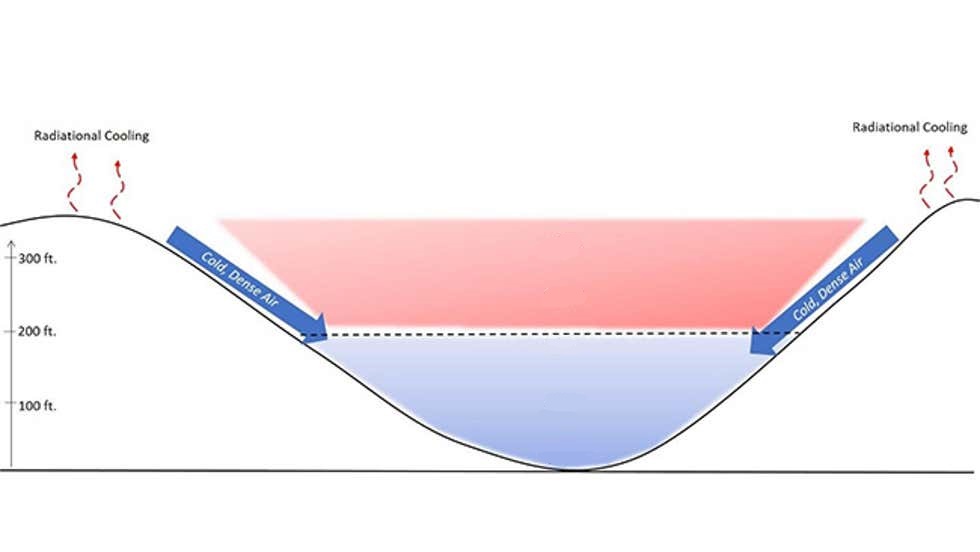
Under these conditions the ground will radiate heat during the night, and the temperature falls at a uniform rate. Then a thin layer of cold air will form next to the cold ground.
The cold air will then flow down a slope, until it reaches a low point from which it can’t escape. This is a frost pocket or temperature sink.
However air is not a good conductor of heat. So in the absence of convection and mixing, the temperature a few feet off the ground will not be anywhere near as cold.
As soon as the the Sun comes up, even before it is visible (behind the hills in Dol), there is Infrared radiation. This begins to heat the ground, then suddenly there’s air mixing.
The very cold air mixes with the warmer air and lowers its temperature. As the Infrared radiation increases, then the temperature is seen to quickly rise.
Meteorological thermometers are usually placed between 1.2 and 1.8 meters above the surface. My thermometer is at a height of 1.7 meters, so it meets the international standard, but does not record the surface temperature.
When I loooked at the next nearest weather station, which is down in Stari Grad, this is what I saw.
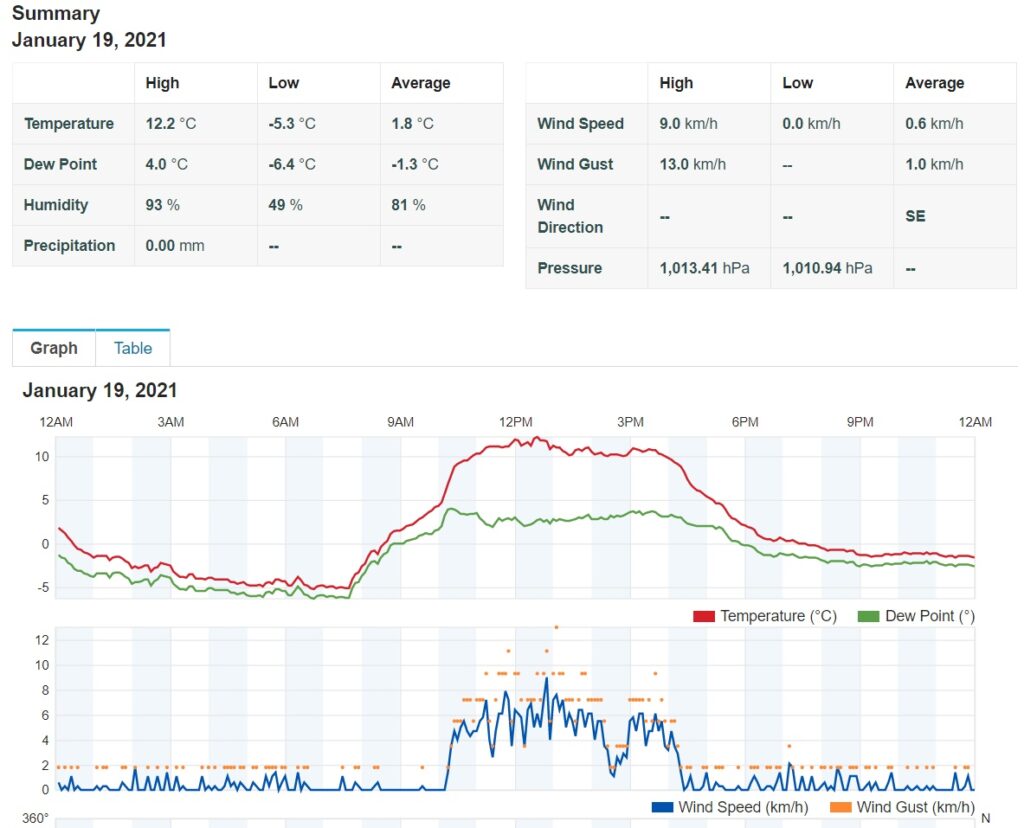
The minimum temperature recorded was -5.3ºC. The temperature in Stari Grad had been below zero from 00:30 to 08:30.
This is because of the effect of the town being in a temperature sink. The cold air flows downhill and collects there.
This elevation transect runs through my weather station (on the left) and the station in Stari Grad.
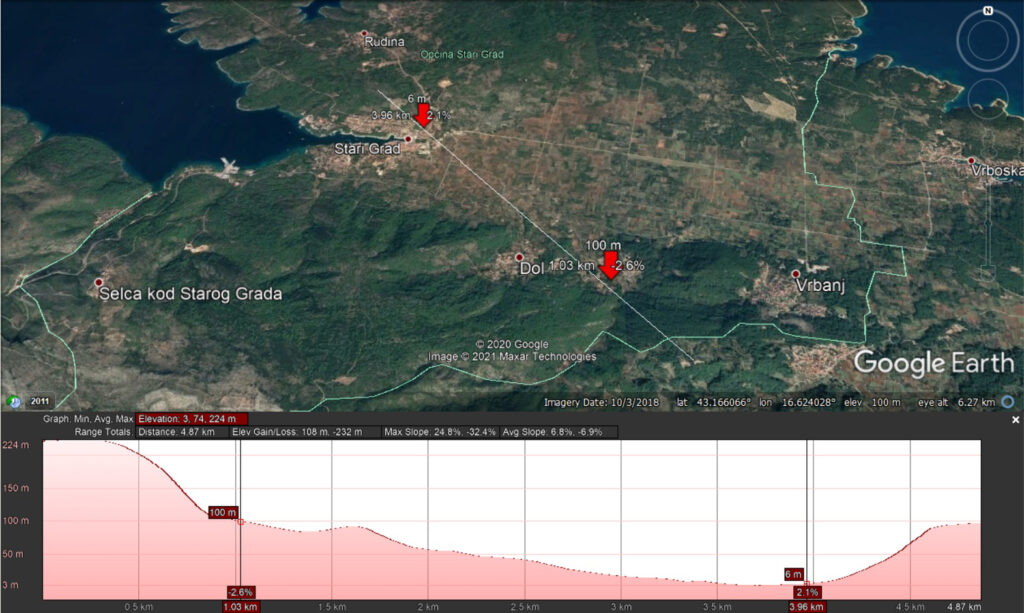
The lack of air movement in Stari Grad is also noticeable when compared to my station, over the same timescale.
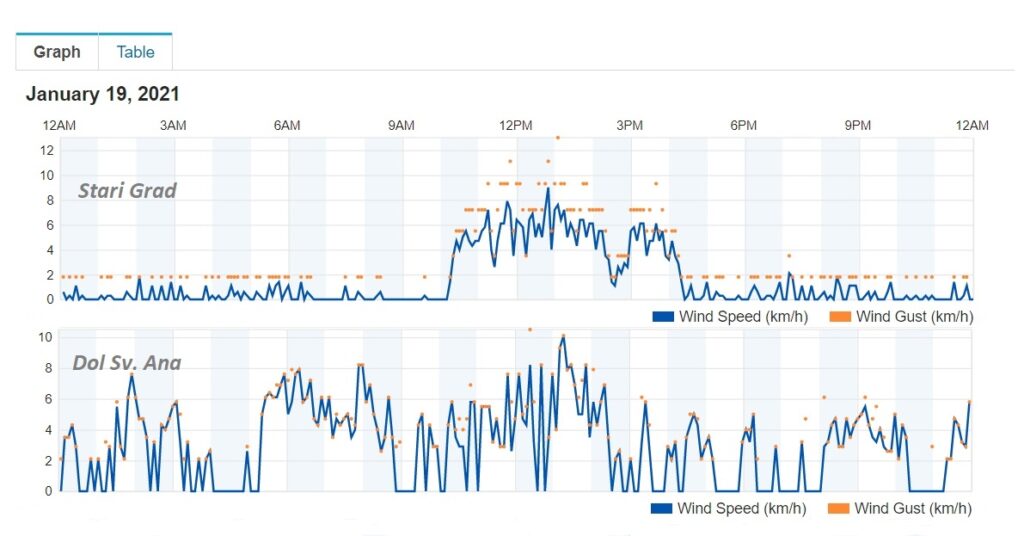
There is only a 100 meter vertical difference and a 3,000 meter horizontal difference, but that translates into a much colder place to live!
There is a very good scientific but easy to understand explanation at the Weather.com website.
Meanwhile….
COVID 19 is still causing difficulties here. The roll out of vaccines to the highest risk groups has ground to a halt after supplies of vaccine ran out.
I am maintaining my policy of “splendid isolation” and only venturing out for shopping, once a week, and at a time when the fewest possible people are likely to be about.
This has meant that there are growing difficulties though. I have now used up almost all my SPAX TORX screws, with just some of the very small 3 x 12 mm and very large 5 x 100 mm sizes in my wall cabinets.
Still thinking about the weather, I have not ordered a replacement weather station yet. This is because I have not yet finished the Stevenson Screen that I built in the orchard last September.
I am ashamed to say that it is no further on than it was on the 12th September when I took this photo.

The problem is simply one of supplies.
I need some small Hardboard pins to fix the wooden wedges that hold the louvres in place and I have used my entire supply. These are specialised copper pins so they will not corrode.

Not only that, I need 15mm long pins and I can’t even get steel pins of that length on the island.
It will have to be a trip to Bauhaus on the mainland, or finding an online supplier, if I can, so I can refill my drawers.
Then there is the second problem. Screwfix.eu who have been my go-to online supplier for all things hardware for the past five years, has stopped supplying to Europe because of the COVID Safe working restrictions in their Irish warehouse.
I’ve been trying to find another similar supplier, but the search for someone with any of the specialist hardware I need, who will sent to Dol, has been illusive.
Even Volat, the ever helpful builders merchants in Stari Grad have been unable to source what I need.
At least they didn’t suggest, as another builders merchant did, buying longer pins than I want and then grinding them down to the size I actually need to use.
Yerr…. Right…..
The thought of individually reducing the length of three hundred or more 1.5 mm diameter pins, just does not appeal to me!
So the hunt continues to find a specialist hardware supplier who will deliver to Croatia.
Meanwhile, the part of the Stevenson Screen I finished has borne everything the winter has thrown at it, without the slightest movement or warping.
I have a lot of wood already cut to make more louvres and the door, so I just need some metal to fasten the wooden bits together. It’s not much to ask for…..
Down in the orchard
The cold weather has burnt the Canna Lilies that are in the side border. I know they are tropical and sub tropical plants, so the above ground parts are not at all frost hardy.
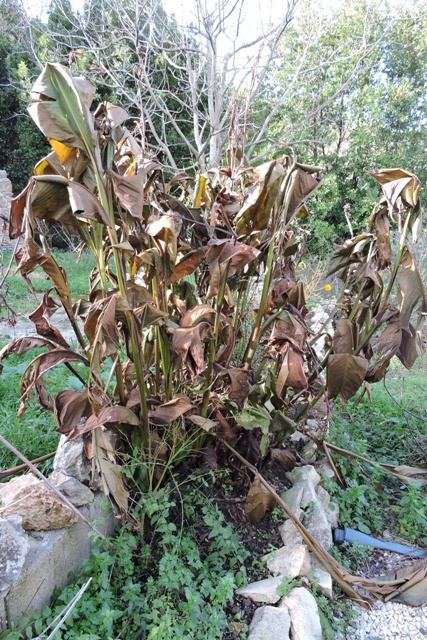
On the 12th December they looked like this and still had some flowers.
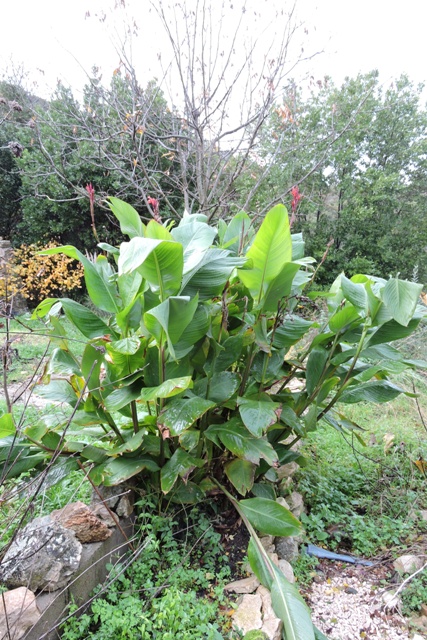
However growing from rhizomes in deep, well draining soils means that they will just grow again as soon as the days lengthen and warm.
When I took a look at the base of the stems, the new shoots have not been touched by the cold. I will leave the dead stems in place to both protect the small shoots and the rhizomes from any more cold.

One shrub that I am really pleased with in the shrubbery, is my Batchelor’s button, Kerria japonica “Plentiflora”. This is a hardy perennial which according to the RHS is just a spring flowering species.
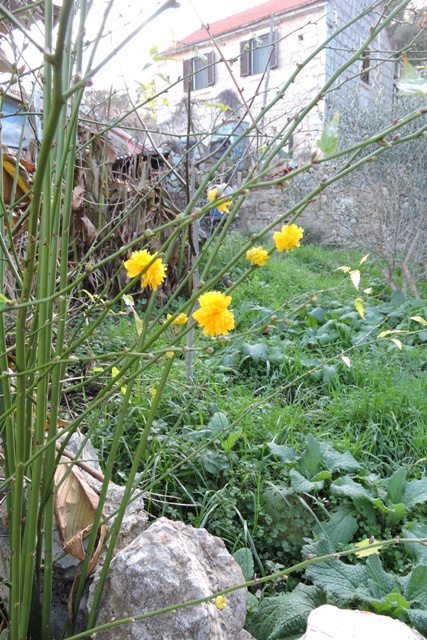
When I had this in the garden of my East Yorkshire home, it certainly brightened the border in the spring. This week it has the first flowers of 2021 on bare stems.
However what I observed last year was that it flowered almost throughout the year. Whether is is a response to the Mediterranean climate, or I have got a different variety, I don’t know. I took this photo in July 2020.

But the bright yellow globular flowers certainly brighten the garden in early spring, long before any leaves have appeared.
Also putting in an appearance this week are the first flower spikes on my Hyacinth bulbs.
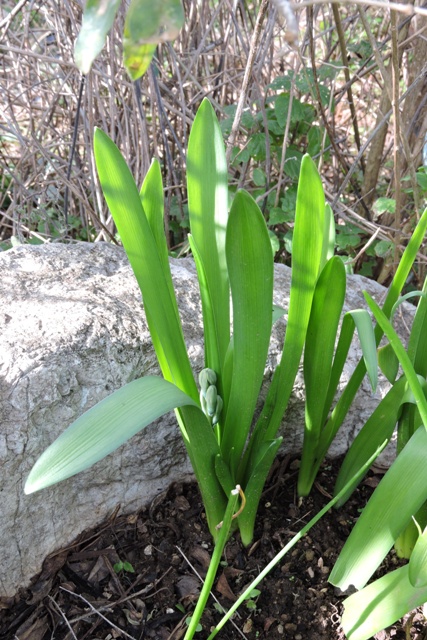
It will be a couple of weeks before the flowers open and release their heady scent, but it is encouraging to see spring advancing.
It worked!
Well, it almost worked….
I’m talking here about the rain cover I built over the first floor walkway between my buildings.
With some rain on Thursday, I was pleased to see that there are only just a couple of places that have small drips.
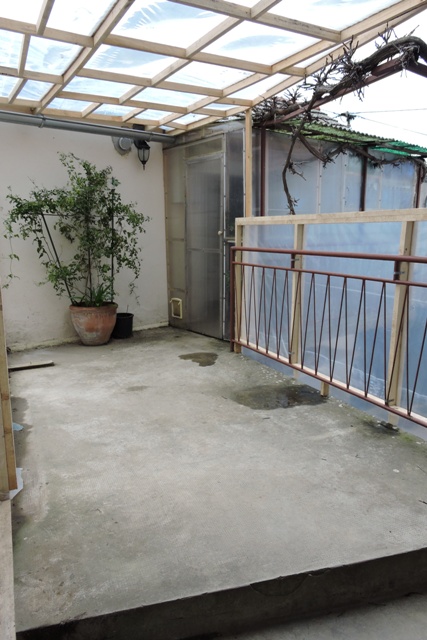
All the patches that I put on the holes made by the felines seem to have worked. The two wet patches are caused by drips from holes I missed.
Once there are a few more dry days, I will be back up on the ladder to patch the places that I have now marked.
I was less happy to find that on Friday morning, Gizmo was back up on the roof, once again exploring the puddles of rain water with his paws (and claws).
I suspect that I am not going to be able to change his antics and will just have to live with the occasional new hole appearing.
This did prompt me to make contact again with the architect, who I had not heard from since before Christmas. I wanted to know what progress has been made with the application for the building permission.
I really am becoming frustrated with living in separate buildings and not seeming to be able to make progress.
The short answer is “not a lot” has happened. But my project is being worked on…. NCG
3 Responses
Andy Robinson
I thought the hour before dawn was the darkest, Norman, not the coldest….. I’ll stand by for you to prove me wrong….
Jonathan
Great to learn of your adventures Norman. Strange times here too! Stay safe!
Tony Griggs
I remember as a kid going around to a friends place whose father ran a sawmill cutting pine. The fire was roaring but there was there was very little heat. By comparison, my Dad used to burn Blackwood which was very hot! There is a big difference between wood sources and temperature. The harder and drier the wood, generally the higher the temperature. I try to have 3 years supply of firewood so what I am using has been drying for 3 years. Here on Flinders Island in Australia we have Sheoak and Macracarpa, as well Tea Tree. All burn hot but the Tea Tree requires at least 2 years to dry as it seems to retain moisture. The reason you get the build up in flu’s is due to moisture in the wood, as well if yr chimney flue isn’t designed to draw properly ( angles don’t help). But I suspect being the sort of guy you are Norman, you are all over this 😊